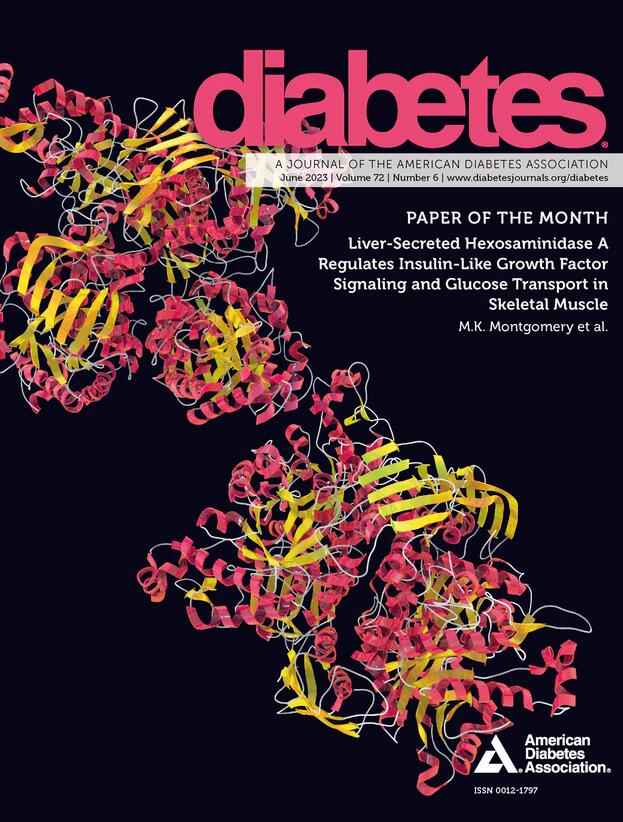1402-P: Topical Administration of Recombinant Human Thrombomodulin Analogue BB-101 in Diabetic Foot Ulcer—A Randomized, Double-blind, Placebo-controlled, Sequential Dose Escalation, Phase I, Clinical Trial
IF 6.2
1区 医学
Q1 ENDOCRINOLOGY & METABOLISM
引用次数: 0
Abstract
Introduction and Objective: Diabetic foot ulcers (DFUs) are a severe complication of diabetes mellitus, characterized by impaired wound healing and high rates of chronicity. BB-101, a recombinant thrombomodulin analogue, mimics thrombomodulin's functions, promoting angiogenesis and fibroblast migration, with potential to enhance wound healing in DFU patients. The primary objectives are to evaluate the safety and tolerability of BB-101 compared with placebo group. Secondary objectives include proportion of subjects with target ulcer that heals within the 4-week treatment period and plasma concentration of BB-101. Methods: This study was a randomized, double-blind, placebo-controlled clinical trial in type 2 DM patients with DFU classified as Wagner grade 1-3, located on the lower leg or foot, with sizes ranging from 0.5-20.0 cm² after debridement. Fifteen participants were randomly assigned to one of three treatment arms: 2 μg/mL BB-101 (low-dose), 20 μg/mL BB-101 (high-dose) or placebo applied to the foot ulcer surface for a treatment duration of 4 weeks, followed by a 2-year follow-up. Weekly photography, quantitative planimetry, and physical examinations documented the ulcer appearance, surface area, and stage. Results: As a result of BB-101 treatment, none of the serious adverse events were attributed to the treatment, and no treatment-emergent adverse events led to dose interruption or withdrawal. Patients in either the low- or high- dose group tested negative for anti-BB-101 antibodies at any visit. The low-dose group showed wound reductions from 1.38-3.03 cm² to complete closure in some cases, while high-dose treatment achieved reductions from 4.39-2.67 cm² to 0.14 cm². Both groups demonstrated consistent and increasing wound tissue proliferation and significant healing progression. Conclusion: Participants receiving BB-101 represented excellent safety profile associated with DFU, paving the way for a new era in DFU care. This study lays the groundwork for further large scale randomized clinical studies. Disclosure J. Ding: Employee; Blue Blood Biotech Corp., Sanar Biotech Corp. P. Fan: None. C. Lin: Employee; Blue Blood Biotech Corp. Consultant; Sanar Biotech Corp. G. Young: None. L. Lo: None. S. Chaichuum: None.1402-P:重组人血栓调节素类似物BB-101局部治疗糖尿病足溃疡——随机、双盲、安慰剂对照、顺序剂量递增,I期临床试验
简介和目的:糖尿病足溃疡(DFUs)是糖尿病的一种严重并发症,其特点是伤口愈合受损,慢性发生率高。BB-101是一种重组血栓调节蛋白类似物,模拟血栓调节蛋白的功能,促进血管生成和成纤维细胞迁移,有可能促进DFU患者的伤口愈合。主要目的是评价BB-101与安慰剂组的安全性和耐受性。次要目标包括目标溃疡在4周治疗期内愈合的受试者比例和BB-101的血浆浓度。方法:本研究是一项随机、双盲、安慰剂对照的临床试验,研究对象为2型DM患者,并伴有Wagner 1-3级DFU,位于小腿或足部,清创后大小为0.5-20.0 cm²。15名参与者被随机分配到三个治疗组中的一个:2 μg/mL BB-101(低剂量),20 μg/mL BB-101(高剂量)或安慰剂应用于足部溃疡表面,治疗持续4周,随后进行2年随访。每周摄影、定量平面测量和体格检查记录溃疡的外观、表面面积和分期。结果:经BB-101治疗后,所有严重不良事件均未因治疗而发生,且未发生因治疗引起的不良事件导致给药中断或停药。低剂量组和高剂量组的患者在每次就诊时抗bb -101抗体检测均为阴性。低剂量组部分病例创面缩小,从1.38 ~ 3.03 cm²至完全闭合,而高剂量组创面缩小,从4.39 ~ 2.67 cm²至0.14 cm²。两组均表现出一致且增加的伤口组织增殖和显著的愈合进展。结论:接受BB-101治疗的患者具有与DFU相关的良好安全性,为DFU治疗的新时代铺平了道路。本研究为进一步的大规模随机临床研究奠定了基础。丁杰:员工;Blue Blood Biotech Corp.、Sanar Biotech Corp.:没有。林:员工;Blue Blood Biotech公司顾问;杨格:没有。卢:没有。查丘姆:没有。
本文章由计算机程序翻译,如有差异,请以英文原文为准。
求助全文
约1分钟内获得全文
求助全文
来源期刊

Diabetes
医学-内分泌学与代谢
CiteScore
12.50
自引率
2.60%
发文量
1968
审稿时长
1 months
期刊介绍:
Diabetes is a scientific journal that publishes original research exploring the physiological and pathophysiological aspects of diabetes mellitus. We encourage submissions of manuscripts pertaining to laboratory, animal, or human research, covering a wide range of topics. Our primary focus is on investigative reports investigating various aspects such as the development and progression of diabetes, along with its associated complications. We also welcome studies delving into normal and pathological pancreatic islet function and intermediary metabolism, as well as exploring the mechanisms of drug and hormone action from a pharmacological perspective. Additionally, we encourage submissions that delve into the biochemical and molecular aspects of both normal and abnormal biological processes.
However, it is important to note that we do not publish studies relating to diabetes education or the application of accepted therapeutic and diagnostic approaches to patients with diabetes mellitus. Our aim is to provide a platform for research that contributes to advancing our understanding of the underlying mechanisms and processes of diabetes.
 求助内容:
求助内容: 应助结果提醒方式:
应助结果提醒方式:


